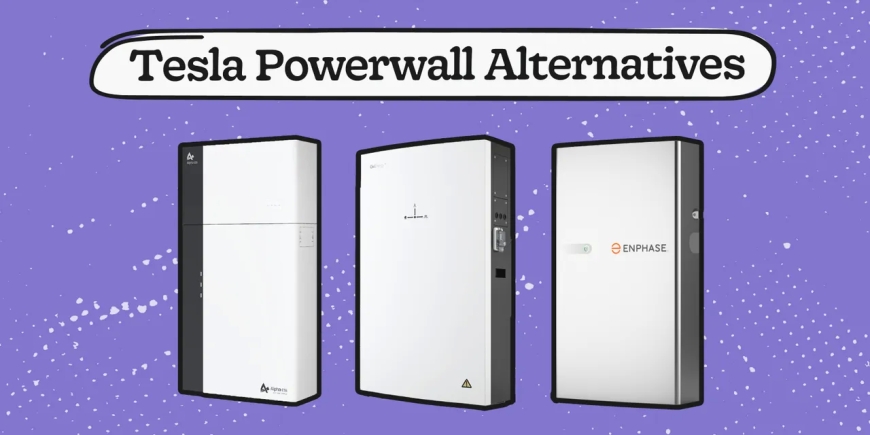Exploring the Best Tesla Powerwall 3 Alternatives for Your Home Energy Needs
Discover top Tesla Powerwall 3 Alternatives like FranklinWH, Enphase, Generac, and Panasonic. Compare features, prices, and benefits for your home energy needs.

The wind howled outside Sarah’s rural home as a fierce storm knocked out the grid, plunging her world into darkness. Her family huddled around a flickering candle, longing for the hum of electricity to return. Sarah had been researching solar batteries, drawn to the sleek Tesla Powerwall 3, but its steep price and long wait times gave her pause. What if there were other options—reliable, powerful, and budget-friendly—that could keep her home glowing through the storm? This question led her to explore Tesla Powerwall 3 Alternatives, and her journey mirrors that of countless homeowners seeking energy independence. In this article, we’ll dive into the top alternatives to the Tesla Powerwall 3, comparing their features, benefits, and real-world performance to help you find the perfect fit for your home.
Why Consider Tesla Powerwall 3 Alternatives?
The Tesla Powerwall 3 is a standout in home energy storage, boasting a 13.5 kWh capacity, 11.5 kW power output, and seamless solar integration. However, its $10,500 price tag (before installation), 3-6 month wait times, and lack of generator compatibility make it less ideal for some. Homeowners like Sarah may also want modular systems, better warranties, or brands that align with their values. Fortunately, Tesla Powerwall 3 Alternatives offer competitive features tailored to diverse needs, from whole-home backup to budget-conscious solutions.
Factors to Evaluate in Alternatives
When exploring alternatives, consider these key metrics:
- Storage Capacity: How much energy can the battery store (measured in kWh)?
- Power Output: Can it handle high-demand appliances (measured in kW)?
- Efficiency: What’s the round-trip efficiency for energy retention?
- Scalability: Can you add more units for increased capacity?
- Warranty and Cost: Does the warranty match the lifespan, and is the price affordable?
- Compatibility: Does it work with existing solar systems or generators?
Top Tesla Powerwall 3 Alternatives
Here are four of the best Tesla Powerwall 3 Alternatives in 2025, each excelling in specific scenarios based on recent reviews and expert insights.
1. FranklinWH aPower 2: The All-in-One Powerhouse
The FranklinWH aPower 2 is a top contender for homeowners seeking a near-identical alternative to the Tesla Powerwall 3. With a 13.6 kWh capacity and 10 kW continuous power output, it matches the Powerwall’s ability to run major appliances during outages. Its 92% round-trip efficiency and compatibility with any solar inverter make it a flexible choice for both new and existing systems.
Why Choose FranklinWH?
- Whole-Home Backup: Supports high-demand homes with seamless grid transitions.
- Superior Warranty: Offers a 12-year warranty compared to Tesla’s 10 years.
- Retrofit-Friendly: Easily integrates with existing solar setups, unlike some competitors.
- Price: Approximately $9,500-$11,000, potentially cheaper than the Powerwall 3.
Best For: Homeowners with existing solar systems or those prioritizing reliability and warranty.
2. Enphase IQ Battery 5P: Modular and Microinverter-Friendly
The Enphase IQ Battery 5P is a compact, modular option with a 5 kWh capacity and 3.84 kW continuous output, ideal for smaller homes or partial backup. Its lithium iron phosphate (LFP) chemistry ensures safety and longevity, and it integrates flawlessly with Enphase microinverters. Stack multiple units to reach up to 60 kWh for larger needs.
Why Choose Enphase?
- Modular Design: Start small and scale up as energy demands grow.
- High Efficiency: 90% round-trip efficiency minimizes energy loss.
- Long Warranty: Comes with a 15-year warranty, outlasting the Powerwall 3.
- Price: Starts at $3,300 per unit, but multiple units may raise costs.
Best For: Enphase solar system owners or those seeking scalable, compact solutions.
3. Generac PWRcell 2: Generator-Compatible Flexibility
The Generac PWRcell 2 shines for off-grid enthusiasts or those in outage-prone areas. With a modular design offering 9-36 kWh capacity (via 3 kWh modules) and up to 12 kW output, it’s a robust alternative. Its ability to pair with propane, natural gas, or diesel generators sets it apart from the Powerwall 3, which lacks generator support.
Why Choose Generac?
- Generator Integration: Perfect for extended outages in rural or storm-prone regions.
- Scalability: Expand up to 36 kWh with additional modules.
- Cost-Effective: A 9 kWh setup starts at $11,000, with tax credits reducing costs.
- Price: $11,000-$15,000 depending on configuration.
Best For: Homes with generators or high energy demands in outage-prone areas.
4. Panasonic EverVolt 2.0: Hybrid Versatility
The Panasonic EverVolt 2.0 is a hybrid (AC/DC-coupled) battery with a 5 kWh base module, stackable up to 72 kWh. Its 94% round-trip efficiency outperforms the Powerwall 3’s 90%, and its built-in solar charger simplifies installation. With a 12-year warranty and compatibility with new or existing solar systems, it’s a reliable choice.
Why Choose Panasonic?
- High Efficiency: Maximizes energy retention for cost savings.
- Flexible Capacity: Scales from 5 kWh to 72 kWh for any home size.
- Trusted Brand: Panasonic’s reputation ensures long-term support.
- Price: Starts at $9,500 for a 10 kWh system.
Best For: Homeowners seeking high efficiency and brand reliability.
How to Choose the Right Alternative
Selecting the best alternative depends on your home’s energy needs:
- Small Homes: Enphase IQ Battery 5P for compact, scalable storage.
- Large Homes: FranklinWH aPower 2 or Generac PWRcell 2 for whole-home backup.
- Budget-Conscious: Panasonic EverVolt 2.0 for high efficiency at a lower starting cost.
- Outage-Prone Areas: Generac PWRcell 2 for generator compatibility.
Consult a certified installer to assess your solar system and energy consumption. Platforms like EnergySage can provide free quotes to compare options.
Conclusion
Sarah’s stormy night sparked a quest for energy independence, and her discovery of Tesla Powerwall 3 Alternatives opened a world of possibilities. From the FranklinWH aPower 2’s robust whole-home backup to the Enphase IQ Battery 5P’s modular flexibility, Generac PWRcell 2’s generator support, and Panasonic EverVolt 2.0’s efficiency, these alternatives prove you don’t need a Tesla to power your home reliably. By evaluating capacity, output, efficiency, and compatibility, you can choose a battery that fits your budget and lifestyle. Embrace the future of clean energy with confidence, knowing the perfect solution is within reach—storm or shine.
What's Your Reaction?
 Like
0
Like
0
 Dislike
0
Dislike
0
 Love
0
Love
0
 Funny
0
Funny
0
 Angry
0
Angry
0
 Sad
0
Sad
0
 Wow
0
Wow
0








































